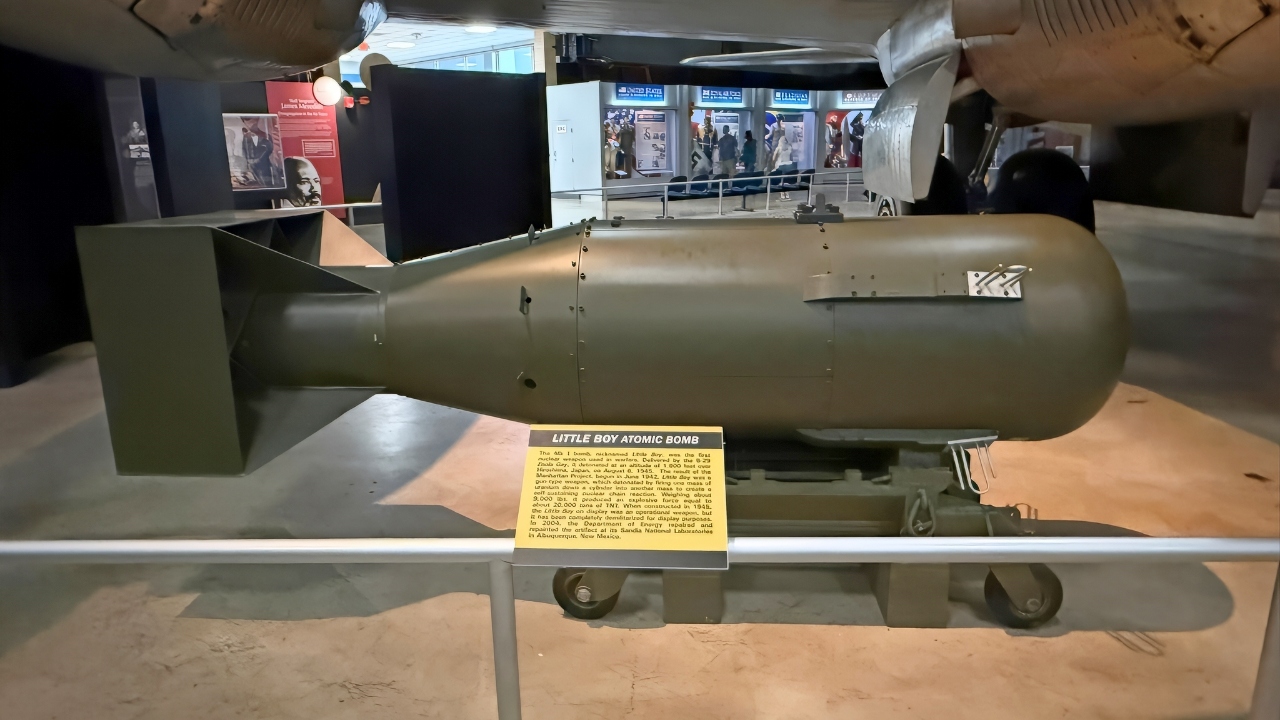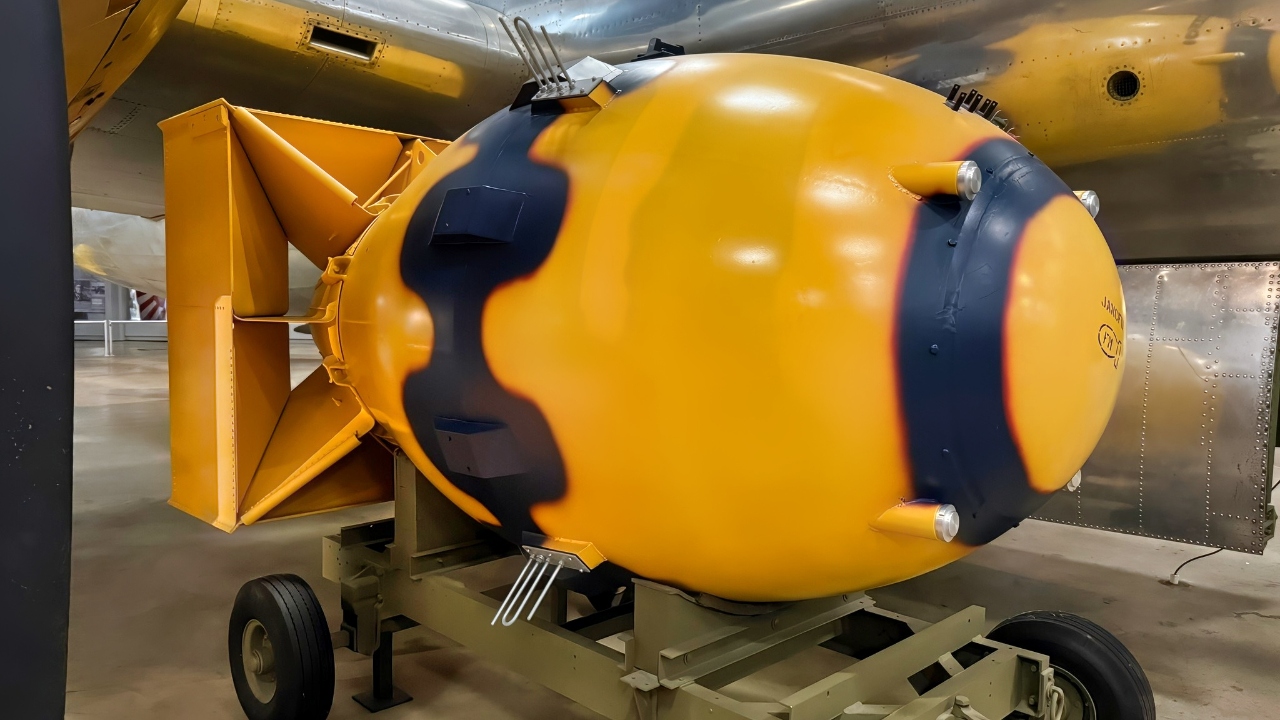Key Points and Summary – President Trump has “created a stir” by suggesting the U.S. may resume nuclear weapons testing for the first time since its 1992 moratorium, a “provocative” move.
-This is seen as a reaction to Russian “doomsday” weapons tests (like the Poseidon torpedo) and “perceived” low-yield tests by Russia and China, which most experts view as “inconsequential.”

Little Boy Atomic Bomb. Image Credit: Harry J. Kazianis/National Security Journal.
-The op-ed argues this is a “mistake” that would be costly (the 30-year-old infrastructure is “gone”), “damage delicate ecosystems,” and encourage rivals to build up nuclear forces.
Trump and the Nuclear Weapons Threat
Is the United States about to start testing nuclear weapons again? Recent comments by United States President Trump suggested that he is strongly considering testing nuclear warheads in response to real and perceived tests by other nuclear powers.
These comments left many confused about the future of US policy and the state of intelligence on adversary nuclear programs.
So what’s going on? As is often the case, President Trump seems to prize unpredictability.
We don’t know what’s going to happen, but it wouldn’t hurt to review where we’ve been.
The Nuclear Weapons Testing Moratorium
The United States last tested a nuclear device on September 23, 1992. Operation Julin “Divider” was an underground test of a 5 kiloton (KT) device, the last of a series of tests that would mark the end of some forty-seven years of US nuclear testing. Shortly after this test, the United States would embrace a testing moratorium in preparation for negotiations to create and join the Comprehensive Test Ban Treaty (CTBT).
That treaty was signed on September 24, 1996, but has not entered into force because several key states (including the US, Russia, and China) have signed but not ratified it. Nevertheless, testing of nuclear devices has dropped dramatically since the signing of the CTBT, with only India, Pakistan, and North Korea conducting weapons tests.
Arguments against a resumption of testing are straightforward; nuclear tests unnecessarily damage delicate ecosystems while also ratcheting up international tensions. All of the major powers have sufficient confidence in their own nuclear arsenals to forego additional testing.
Moreover, tests of new kinds of devices serve to legitimate the idea that nuclear warheads are “normal” weapons that can fit into broadly conventional warplanning. Arms control advocates (along with most of the diplomatic community) celebrated efforts to limit nuclear testing as a major achievement in reducing Cold War and post-Cold War tensions.

Fat Boy Nuclear Bomb At the U.S. Air Force Museum. Photo Credit: Harry J. Kazianis/National Security Journal Original Photo.
On the other hand, advocates of testing have argued that the credibility of the US nuclear deterrent is at stake if the US doesn’t test new and updated warheads.
While individual components can be tested independently, and computers can simulate large-scale nuclear explosions, there is no substitute for a full-scale test.
Also, advocates of resuming US testing have argued that, in addition to the Pakistani, Indian, and North Korean tests, Russia and China have engaged in low-yield testing of warheads and warhead components in violation of the normative structure established in the CTBT.
Trump Determined to Test
For decades, the prohibitionists have carried the day, even resisting arguments to test during the George W. Bush administration.
So what is spurring President Trump’s interest in testing?
Some believe that the President is reacting to recent tests of nuclear delivery systems by Russia, in particular the “Poseidon” undersea drone and the Burevestnik cruise missile.
These high-profile tests captured headlines and seemed to suggest that Russia had weapons that the United States did not, even though the tests involved delivery systems rather than warheads.
Public discussion over the last week has suggested that President Trump sees the possibility of Russian and Chinese low-yield testing as a significant problem, despite the fact that very few nuclear specialists believe that such tests give Moscow or Beijing any considerable advantage.
Others believe that the President simply doesn’t have a very solid idea of what testing nuclear weapons would entail, and is simply speaking off the cuff in a provocative manner, as is his wont.
Implications
No one quite knows what will happen if the United States resumes testing, or what form that testing would take. For one, the physical infrastructure and human capital of the legacy testing regime are gone; little survives after thirty years of the expertise needed to conduct tests.
Such expertise could certainly be rebuilt, but only at considerable cost. Nuclear tests can be conducted in ways that minimize environmental destruction, but building out the infrastructure would still require time and care.
It’s not obvious what the United States would learn from tests (either of low and no yield devices or, eventually, of larger warheads) beyond the fact that “hey, these things work!” but other countries would certainly learn that the US commitment to non-proliferation and eventually to denuclearization had waned into virtual non-existence.
The world has certainly survived periods in which nuclear tests were common. Still, a resumption of US testing would undoubtedly lead to reciprocal behavior on the part of China and Russia.
What Happens Now?
President Trump has made clear that he does not trust the work of the US national security and diplomatic establishments.
Thus, arguments about decades of precedent and restraint carry little weight in his administration.
Indeed, “we have done it this way for a very long time” seems to be viewed as an active negative by the President.
Whether President Trump understands the technical aspects of nuclear testing is uncertain and, to some extent, beside the point.
Trump views himself as a transformational, nigh revolutionary President in both domestic and international policy, and the very idea that China and Russia might be gaining some advantage through otherwise inconsequential cheating may well incline him towards the restoration of a testing program.
On the other hand, the same impulse could drive him in the direction of a more robust arms control regime, a possibility raised on the popular “Arms Control Wonk” podcast. Forcing a ratification of the CTBT in the US, Russia, and China might actually get Trump the Nobel Prize that he so openly desires.
Unfortunately, it’s awfully difficult to see how we get from here to there.
About the Author: Dr. Robert Farley
Dr. Robert Farley has taught security and diplomacy courses at the Patterson School since 2005. He received his BS from the University of Oregon in 1997 and his Ph. D. from the University of Washington in 2004. Dr. Farley is the author of Grounded: The Case for Abolishing the United States Air Force (University Press of Kentucky, 2014), the Battleship Book (Wildside, 2016), Patents for Power: Intellectual Property Law and the Diffusion of Military Technology (University of Chicago, 2020), and most recently Waging War with Gold: National Security and the Finance Domain Across the Ages (Lynne Rienner, 2023). He has contributed extensively to a number of journals and magazines, including the National Interest, the Diplomat: APAC, World Politics Review, and the American Prospect. Dr. Farley is also a founder and senior editor of Lawyers, Guns and Money.
More Military
China Might Have a Way to ‘Swarm’ U.S. Navy Aircraft Carriers
India Leases Russia’s ‘Stealth’ Nuclear Attack Submarines
The Mach 3 SR-71 Blackbird Deserves A Better Fate Than This
The F-14 Tomcat Fighter Was ‘Notoriously Difficult and Costly to Keep Operational’











Jim
November 9, 2025 at 12:21 pm
I go with the idea that Trump was told about Russia testing a “nuclear” device and wanted to match anything Russia was doing.
But at the time didn’t make the distinction between testing a nuclear delivery system as opposed to a “nuclear test” of the warhead, itself.
But Trump isn’t going to publicly admit he misunderstood what was going on.
So, to cover for that misunderstanding, we are having to go through all kinds of public gymnastics to make Trump not look so uniformed.
Hopefully, with time to let things settle down, the idea of conducting a “nuclear test” will quietly be put on the back shelf… that often happens with Trump.
As is often the case with Trump you have to wait and see what actually happens, not get hung up on what he says during his off the cuff public remarks at the door to his cabin on Air Force One.